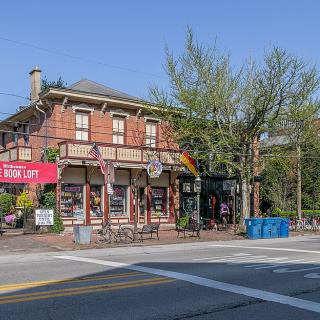Foreword: Columbus, Ohio, exposes itself embarrassingly….
If I, as the holder a Ph.D., am barely able to comprehend the intentionally garbled and misleading rhetorical constructions of all of the City of Columbus, Ohio’s purposefully overwhelming number of off-year propositions and charter amendments in the November 2022 election, the City itself violates the newly-approved charter amendment outlawing self-dealing voter initiatives and dropping the 1914 stipulation that competitive testing must be part of the city’s hiring process.
Indeed the number, the linguistic misconstruction, the disorganization, and the mangled presentation of the bond proposals is itself a clear and compelling example of City Council’s purposeful “self-dealing.” Or shall we say “double-dealing”?
The dishonest wording, verbal distortions, and paid advertising only add to the legal violations if only the new ordinance had been in effect one day earlier. For example, the impact, coverage, and liability to taxpayers of the “affordable housing” proposition is misrepresented. Even worse is the fraudulent “public safety” canard which is a construction plan that has no direct bearing on the publics’ safety.
The two together lay the foundation for more gifts to Council’s, the Mayor’s, and ex-Mayor’s contractor/financier buddies. And to more tax abatements and TIFFs that cripple the city’s public schools and police force, such as they are. Distortingly presented as preventing the next ProEnergyOhio “scam,” this is the City’s own scam. That of course is The Columbus Way. Tried and true, it is the City’s unpaved, broken path to failure, mirroring its streets, sidewalks, filth, and lack of sanitation.
No different is the removal of civil service hiring guardrails—on equally false pretenses. What could be more blatantly “self-dealing” than removing all historical, rational, sensible, tried and true, and well-established practices to sanction an unchecked mayor and council self-serving and personal rewarding free-for-all, except, that is, near total disrespect for the residents and taxpayers who foot the bill. We know too that the mayor and his office (yes, Mr. Mayor, you are responsible for your office!) unethically and illegitimately lobbied about this as well as his already too high salary.
No more comprehensible is the City Attorney’s and Council’s mad rush to pass a limited “gun control” measure during a Franklin County judge’s necessarily brief stay of a state “gun rights” law. Suddenly, the City Attorney who asserted that he lacks the legal standing to sue AEP but not Kia and Hyundai, and proclaims that he won’t enforce anti-abortion measures over which he has no jurisdiction, leads the charge to pass what will undoubtedly be a momentary halt in the legislature-passed and governor-signed fake “gun rights” bill. The increasingly right-wing Republican State Supreme Court, let alone the federal district court and the US unSupreme Court, will overrule faster than we can spell G-i-n-t-h-e-r, Z-a-c-h K-l-e-i-n, and S-h-a-n-n-o-n H-a-r-d-i-n.
At the same time, the mayor and “president” of City Council lead in weakening an already decimated police force—that has the highest rates of officers living outside the city, levels of terminal shootings of unarmed young black men, and is under active Department of Justice investigation for systemic racism. No one can do simple arithmetic and see the connection between tax abatements and underfunding of fundamental public services. Of course, there is no conception of “the public” or even more “the publics” in City Hall.
No one mentions proved-to-succeed responsible buy-back programs that have been recommended to the City for years. Ginther and Hardin can’t sloganeer—however poorly—about that. “Violent crime is a public health crisis.” “I’ll do whatever it takes…,” in other words, mutter and sputter with no plan, concrete proposals, timetable, budget, or measures of accountability. That’s the Columbus, Ohio Way in Ginther’s unimaginative replays of his predecessor.
Is all this noise primarily about future election aspirations and fund-raising campaigns? It’s clearly not about serving their publics. Forgive me, a student of cities for more than 50 years, for not understanding….
Predictably, in less than one day after the gushing, attention-seeking, and wasteful show-and-not-tell, the county judge stayed his earlier ruling at the request of Ohio Attorney General Yo Yost.
Now, to my main theme, another installment in my ongoing effort to give the city with no history and no identity at least a rhetorical foundation. Is “America’s Opportunity for a few City’s” 3rd rate slogan-spouting mayor Columbus, Ohio’s own version of New York City’s notoriously corrupt Mayor William Magear Tweed (1823-1878)? Best known as “Boss” Tweed, he was the political boss of Tammany Hall, the Democratic Party’s political machine that played a major role in mid-to late 19th century New York City and state.
With both, the key is: follow the money.
I ask: can we analogize Ginther to Tweed along the lines of comparing Columbus, Ohio to New York City? The Columbus Democratic “machine” ratcheted up by Ginther’s godfather and predecessor Michael Coleman to Tammany Hall? And Ginther’s lawlessness to the real Boss’s epochal corruption that led to his conviction for stealing up to an estimated $200 million (1860s-1870s $s). Imprisoned, Tweed escaped once but was captured. He died at age 55 in the Ludlow Street Jail.
Unlike Ginther, Boss Tweed—the 19th century The Boss—was self-made, not the creation of sponsored mobility. Tweed was hard-working and multiple active: the third largest landowner in NYC; a director of the Erie Railroad, Tenth National Bank, New-York Printing Company; proprietor of the Metropolitan Hotel; significant stockholder in iron mines and gas companies; broad member of Third Avenue Railway Company; and president of Guardian Savings Bank.
In other words, The Boss was hard-working, financially-active, and successful in the terms of his times and historical context. He did not illegally and unethically lobby his own city government for an undeserved pay raise, let alone blame his own staff as if the mayor were not responsible for the mayor’s staff.
Ginther’s early “public service” is marked by the attendance scandal while he was head of the Columbus City Schools. This was a prelude to his sponsored movement to City Council and then Coleman’s chosen heir.
In contrast to Ginther, Tweed was elected to the US House of Representatives in1852 and New York County Board of Supervisors in 1858, the year he became head of the Tammany Hall political machine. He was also elected to the New York State Senate in 1867.
Boss Tweed’s greatest influence—and path to his downfall—followed from serving as an appointed member of many board and commissions, power in political patronage, and securing the loyalty of voters through his control over jobs that he could create and award on city-related projects.
Here the connection is unmistakable: from Ginther’s Council’s awarding grants and contracts to their connections and contributors (with slim proposals and no accountability—including the unqualified and unlicensed), tax abatements and TIFFs that reward certain private and pseudo public interests but harm the city, and after Nov. 8 the ability to hire “civil servants” with no checks and balances.
Tweed’s path to his legal is reminiscent of the activities of Ginther’s predecessors and teachers.
Both The Boss and Mr. “Opportunity for the few” thrive on conflict of interest, rewarding cronies and contributors, and deceiving their publics. For Ginther, this is a blatant rejection of democracy, the Columbus, Ohio Way.
The Boss also led by slogans, but the evidence suggests that he was far more knowledgeable and engaged in his much larger, more complicated city. Consider Ginther’s latest punch line in “previewing” his 2023 budget proposal on the day that City Council’s chair of the Finance Committee resigns her position. Among his feigns and dodges on policy and trash collections, and superfunding for recycling contractor Rumpke who violates its contract week by week: “We will not rest until Columbus is the safest big city in the country.”
I ask: does he mean “safest for the few city”? No, mayor, the numbers do not align, and there are no starts in your skies. Only police helicopters violating their own regulations and avoiding downtown and the diminishing Short North.
There is another powerful difference beyond Tweed’s expertise and success, and Ginther’s. Tweed was brought down through investigations and public exposure by the New York Times and Harper’s Weekly’s brilliant cartoonist Thomas Nast, despite the Tweed Ring’s efforts to pay them not to publish. Columbus has no such media.
History is never predictive, a fact that today’s pundits and the media never learned. But it does raise questions about gushing, urban ignorant, and innumerate Andy’s future.
--------------------------------------------
Harvey J. Graff is Professor Emeritus of English and History at The Ohio State University and inaugural Ohio Eminent Scholar in Literacy Studies. Author of many books, he writes about a variety of contemporary and historical topics for Times Higher Education, Inside Higher Education, Academe Blog, Washington Monthly, Publishers Weekly, Against the Current; Columbus Free Press, and newspapers. Searching for Literacy: The Social and Intellectual Origins of Literacy Studies was published by Palgrave Macmillan in August. My Life with Literacy: The Continuing Education of a Historian. The Intersections of the Personal, the Political, the Academic, and Place is forthcoming.



